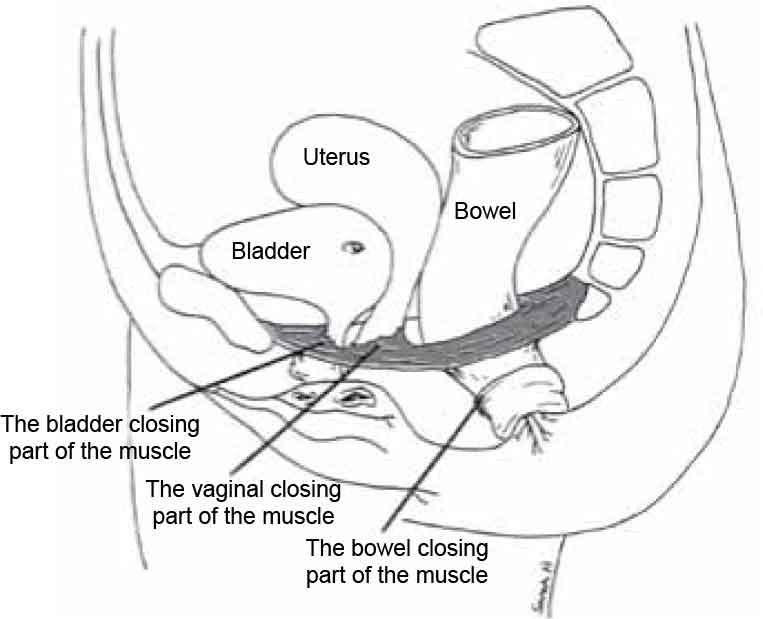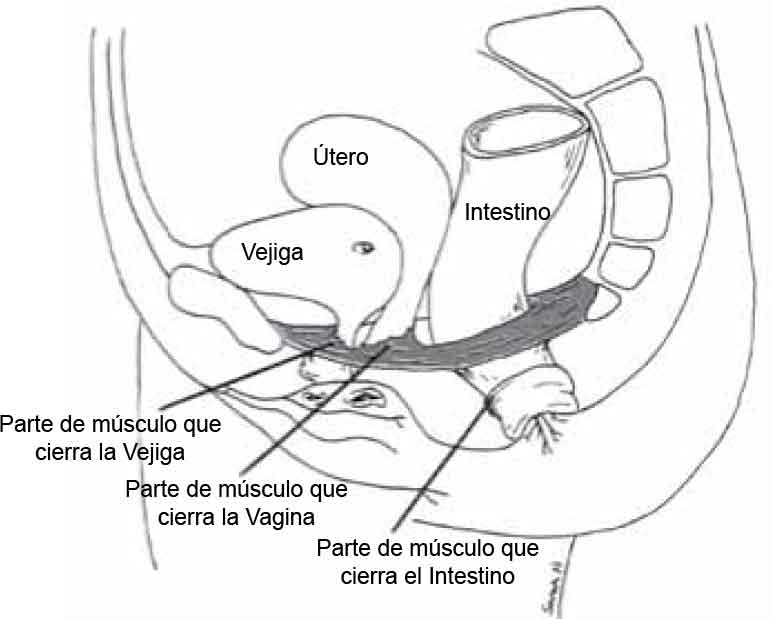|
Women who have even just one baby are nearly three times more likely to leak urine and wet themselves, than women who have not had a baby. The more babies you have, the more chance there is that you will leak urine and wet yourself. |
En comparación con una mujer que nunca ha tenido hijos, la posibilidad de que una mujer que ha tenido aunque sea un solo bebé se orine involuntariamente es casi tres veces mayor. Mientras más hijos haya tenido, más posible será que se orine involuntariamente. |
Why do you leak urine after having a baby?When the baby moves down through the birth canal, it stretches the nerves and muscles that keep the bladder shut. These are called the pelvic floor muscles, and they can sometimes be left weak, and not able to keep the bladder from leak ing. Leaking happens mostly when you cough, sneeze, lift or do exercise. It is rare for the bladder to be hurt during birth, but the muscles and nerves often are, and you need to do pelvic floor muscle training to help the muscles get strong again. |
¿Por qué en el período posterior a un parto se me escapa orina involuntariamente?Cuando el bebé pasa a través del canal de nacimiento, estira los nervios y músculos que mantienen la vejiga cerrada. Dichos músculos (llamados músculos pélvicos) luego de un parto a veces quedan débiles, y no son capaces de impedir filtraciones de la vejiga. Las filtraciones de orina ocurren sobre todo al toser, estornudar, levantar pesos o hacer ejercicios. Es raro que la vejiga se dañe durante un parto, pero los músculos y los nervios a menudo sí se dañan, y usted debe entonces hacer ejercicios para restablecer los músculos pélvicos. |
Will this leaking go away by itself?If you have any leaking, it will not go away if you just ignore it. Leaking is likely to stop if you train your pelvic floor muscles, to help get their strength back. If you don’t get pelvic floor muscle strength back after each baby you have, you may start wetting yourself, as the pelvic floor muscles get weaker with age. |
Esta incontinencia urinaria, ¿se sanará por sí sola?Si sufre de cualquier incontinencia, no se sanará con simplemente hacer caso omiso. Si hace ejercicios para robustecer sus músculos pélvicos es posible que cese su incontinencia. Si usted no restablece el vigor de sus músculos pélvicos después de cada parto, es posible que sufra de incontinencia urinaria, ya que los músculos pélvicos se debilitan con la edad. |
How does my bladder work?The bladder is a hollow muscle pump. It fills slowly from the kidneys, and can hold at least one and a half to two cups of urine (300 to 400mls). The bladder outlet tube is kept closed by the pelvic floor muscles. When the bladder is full and you decide to pass urine, the pelvic floor muscles relax when you sit on the toilet, and the bladder squeezes the urine out. Then the same “fill and empty” cycle begins again. |
¿Cómo funciona mi vejiga?La vejiga es una bomba muscular hueca. Se llena lentamente de líquido procedente de los riñones, y puede contener al menos de una y media a dos tazas de orina (300 a 400 mls.) Son los músculos pélvicos los que mantienen cerrado el conducto de salida de la vejiga. Cuando la vejiga está llena y usted decide orinar, al llegar al excusado los músculos pélvicos se relajan, y la vejiga escurre la orina. Luego el mismo ciclo de “llenado y vaciado” vuelve a comenzar. |
What do my pelvic floor muscles do?See the picture of the pelvic floor. The pelvic floor muscles do a number of things, they:
|
¿Cuál es la función de los músculos pélvicos?Examine el dibujo del perineo. Los músculos pélvicos tienen diversas funciones:
|
 |
 |
What happens if my pelvic floor muscles are weak after having my baby?
|
¿Qué ocurre si mis músculos pélvicos están débiles después de un parto?
|
What can I do to stop these things from happening?
|
¿Qué puedo hacer para que no me ocurran estas cosas?
|
How can I care for my weak pelvic floor muscles?The birth of a baby might have stretched your pelvic floor muscles. Any ‘pushing down’ actions in the first weeks after the baby’s birth might stretch the pelvic floor muscles again. You can help to protect your pelvic floor muscles by not pushing down on your pelvic floor. Here are a few ideas to help you.
|
¿Cómo puedo cuidar mis débiles músculos pélvicos?El parto puede haber estirado sus músculos pélvicos. Cualquier movimiento de “empujar hacia abajo” en las primeras semanas después del parto puede ocasionar un nuevo estiramiento de los músculos pélvicos. Usted puede ayudarse a protegerlos al no empujar el perineo hacia abajo. He aquí algunas ideas que pueden ayudarle.
|
Where are my pelvic floor muscles?The first thing to do is to find out which muscles you need to train.
If you don’t feel a distinct “squeeze and lift” of your pelvic floor muscles, or if you can’t stop your stream of urine as talked about in Point 3, ask for help from your doctor, physiotherapist, or continence nurse advisor. They will help you to get your pelvic floor muscles working right. Even women with very weak pelvic floor muscles can gain from pelvic floor muscle training. |
¿Dónde se encuentran mis músculos del perineo?Lo primero es determinar cuáles son los músculos que usted necesita ejercitar.
Si usted no siente un característico “apretar y levantar” de sus músculos del perineo, o bien si usted no logra detener su orina en la forma mencionada en el punto 3, acuda a su doctor, fisioterapeuta o al personal especializado en incontinencia. Son quienes le ayudarán a lograr el buen funcionamiento de sus músculos pélvicos. Aun las mujeres que tienen una muy débil musculatura pélvica pueden beneficiarse con los ejercicios para dichos músculos. |
How do I do pelvic floor muscle training?Now that you can feel the muscles working—
While doing pelvic floor muscle training—
|
¿Cómo puedo hacer ejercicios para los músculos pélvicos?Ahora que puede sentir los músculos en acción podrá
Durante los ejercicios para la musculatura pélvica—
|
Do your pelvic floor muscle training wellFewer good squeezes are better than a lot of half hearted ones! If you are not sure that you are doing the squeezes right ask for help from your doctor, physiotherapist, or continence nurse advisor. |
Ejecute correctamente sus ejercicios para los músculos pélvicosUna cantidad pequeña de buenos apretamientos es mejor que muchos hechos a medias. Si no está segura de cuán bien los hace, acuda a su médico, fisioterapista o enfermera especializada en incontinencia. |
Make the training part of your daily lifeOnce you have learnt how to do pelvic floor muscle squeezes, you should do them often. Every day is best, giving each set of squeezes your full focus. Make a regular time to do your pelvic floor muscle squeezes. This might be when you:
It’s a good idea to get into the lifelong habit of doing one set of pelvic floor muscle exercises every time you go to the toilet, after passing urine or opening your bowels. |
Incorpore estos ejercicios a su vida cotidianaApenas haya aprendido a hacer los apretamientos de los músculos pélvicos, ¡hágalos con frecuencia! Lo mejor es hacerlos todos los días. Haga cada serie de apretamientos con el máximo de concentración. Trate de dedicar un mismo momento del día a estos ejercicios, lo cual puede ser cuando:
Es una buena cosa acostumbrarse, de por vida, a hacer una serie de ejercicios para los músculos pélvicos cada vez que vaya al baño, ya sea después de defecar u orinar. |
What if things don’t improve?Pelvic floor muscle damage may take up to six months to get better. If things are not getting better after six months, speak to your doctor, physiotherapist or continence nurse advisor. |
¿Qué hago si no mejoro?El daño ocasionado a los músculos pélvicos puede tomar hasta seis meses en sanar. Si luego de seis meses no nota mejoría, hable con su doctor, fisioterapeuta o personal especializado en incontinencia. |
Also ask your doctor for help if you notice any of the following:
|
También acuda a su médico si observa cualesquiera de lo siguiente:
|
Seek helpQualified nurses are available if you call the National Continence Helpline on 1800 33 00 66* (Monday to Friday, between 8.00am to 8.00pm Australian Eastern Standard Time) for free:
If you have difficulty speaking or understanding English you can access the Helpline through the free Telephone Interpreter Service on 13 14 50. The phone will be answered in English, so please name the language you speak and wait on the phone. You will be connected to an interpreter who speaks your language. Tell the interpreter you wish to call the National Continence Helpline on 1800 33 00 66. Wait on the phone to be connected and the interpreter will assist you to speak with a continence nurse advisor. All calls are confidential. * Calls from mobile telephones are charged at applicable rates. |
Busque ayudaEl personal de enfermería especializado está disponible llamando gratuitamente a la Línea Nacional de Ayuda para la Incontinencia al 1800 33 00 66* (de lunes a viernes, de 8:00 a 20:00 horas, hora estándar del este de Australia):
Si usted tiene dificultad para hablar o entender Inglés puede acceder a la línea de ayuda a través del Servicio Telefónico gratuito de Intérpretes llamando al 13 14 50. Contestarán a la llamada en ingles, entonces usted diga el nombre del idioma que habla y espere en el teléfono. Le pondrán en contacto con un intérprete que hable su idioma, entonces diga que quiere llamar a la Línea Nacional de Ayuda para la Incontinencia al 1800 33 00 66. Espere a que conecten el teléfono y luego el intérprete le ayudará a hablar con un profesional de enfermería que podrá aconsejarle sobre la incontinencia. Todas las llamadas son confidenciales. * Las llamadas desde teléfonos celulares se cobran a las tarifas aplicables. |
One In Three Women Who Ever Had A Baby Wet Themselves in Spanish in Spanish
Una De Cada Tres Mujeres Que Han Dado A Luz Se Orina Involuntariamente
Last Updated: Fri 30, Jul 2021
Last Reviewed: Tue 17, Mar 2020

